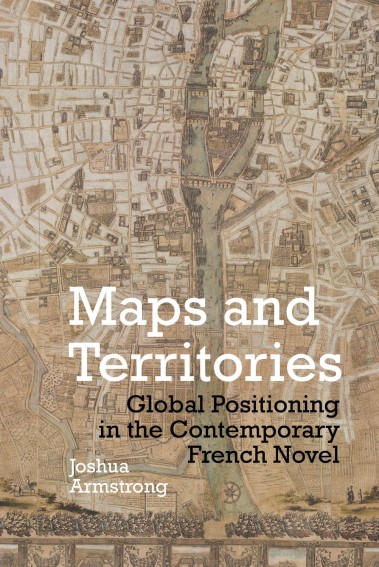‘This book importantly addresses questions that are at the very heart of contemporary debates about our relationship to space and places in a world where borders and distance are being redefined by the forces of globalization.’
– Jean-Xavier Ridon, University of Nottingham
Firstly, could you tell us a bit about Maps and Territories and what inspired you to focus your research in this area?
In Maps and Territories, I set out to address what I see as a fundamental contradiction of our times: that of living in an age where we are aware that the local, and our everyday lives in the local places we call home, are inextricably bound up with global processes that are difficult to locate and comprehend in their structural totality. In other words, in the age of things like the global free-market mass production economy, accelerated communications technologies, and global warming, today one feels called upon to do the impossible: to meaningfully locate oneself at the intersection of the actual global processes that in fact determine and ultimately give meaning to our reality. Of course, this kind of locating of the self within the global is not a matter of drawing a map, and yet, simply the term “locate” conjures the cartographic. And, in fact, it turns out to be the case—in literature, and in culture more generally—that a cartographic imaginary is often deployed in response to the anxieties this conundrum produces. We see it in the proliferation of images of the global that flood our screens depicting a reassuring world that is at once global, fluid, and comprehensible, a world of jumbo jets effortlessly taking off tranquil skies, or panoramic shots of brightly-lit American cities: in short, a utopian globalized world of transparency and continuity. A range of tropes of visibility that draw on the power of maps therefore come to our “rescue” by producing satisfying simplifications of the “global” that are as easy to read as any map. But the map brings its own quandaries. Because maps are so compelling, and pressured as we are to comprehend reality at the global scale, it is perhaps harder than ever to remember that classic maxim: “the map is not the territory.” Forgetting this—being lulled by the satisfying but false and often commercially-inspired representations of our world—leads necessarily either to megalomania or paranoia: the megalomania of those who think their gaze can encompass the totality and therefore confuse the map with the territory, or the paranoia of those who believe themselves to be dominated by such a totalizing gaze, who confuse the territory with the map. The novels I assembled and studied for Maps and Territories are full of the cartographic, the megalomaniacal, and the paranoid. In certain instances, I deconstruct them to show how they surreptitiously mimic those commercial images, producing impossible and yet irresistible panoramas that persuade us we are really seeing—in true megalomaniacal fashion—“the big picture.” Not surprisingly, this tends to be the case for more commercially successful novels, such as Michel Houellebecq’s The Map and the Territory. On the other hand, more experimental novels, like those of Jean Rolin and Marie Darrieussecq, seem to go out of their way to problematize the perceived perfection of the cartographic symbolic regime. This ongoing pursuit of a more meaningful global positioning is, ultimately, vigorously pursued in the contemporary French novel. In their best instances, such works are a much-needed counterpart to the myriad corporate-sponsored and politically-motivated stagings of the world system always available for rapid consumption in today’s paranoid world of planetary preoccupations.
Whilst undertaking your research for the book, did anything surprise you?
I had already, in writing my dissertation, been struck by the prevalence of geographical and cartographic themes in post-1980 experimental French literature. You had authors like Philippe Vasset exploring the parts of Paris left blank on his city map, Jacques Réda taking a walk along the Paris meridian line, Thomas Clerc walking and describing every street of the 10th Arrondissement, providing addresses as he went like a walking psychogeographical GPS. Such trends in French literature, and the resurgence in popularity of psychogeography in the UK, seem to represent, on the surface, celebrations of the local. In my dissertation I focused on the modus operandi of such texts, which I call “empiritexts,” to emphasize how their content is always gleaned in the process of fieldwork and empirical observation. I guess Maps and Territories began when I took a step back and tried to answer the big question of why such experimental texts, often operating at the intersection of cartography and literature, had become a trend in the first place. As I read between the lines, I started seeing such works less as celebrations of the local and more as desperate attempts to respond to precisely that predicament that I see as so fundamental of our age: the injunction to apprehend, inhabit, and forge meaningful relationships to local geographies of increasingly globalized cognitive and ethical parameters. At the same time, I was struck by how cartographic tropes—especially that of panorama—are mobilized by more traditional novels. I wanted to find out more about the relationship between maps and novels, to understand the mechanics that allow a novel to satisfyingly represent a geography, and those that, conversely, enable maps to tell tall tales. This set me on the path of writing Maps and Territories.
How does Maps and Territories pave the way for future research in literary studies and critical cartography?
I would say Maps and Territories paves the way for literary studies by identifying a key catalyst driving contemporary literary production, not just in France, but also in Europe more broadly today, and by defining the parameters of a new literary aesthetic. Reading today’s French novel for how it re-maps the territory, and for how it positions its protagonists vis-à-vis the pressures of globalization, I was able to uncover previously unseen affinities amongst a diverse set of authors—Michel Houellebecq, Chloé Delaume, Lydie Salvayre, Jean-Philippe Toussaint, Virginie Despentes, Philippe Vasset, Jean Rolin, and Marie Darrieussecq. On the one hand, this provides new directions for scholarship on said individual authors; at the same time, it defines a contemporary moment in French society and could suggest studies centering around similar themes in a range of different authors. In fact, as I continue to read new novels after publishing Maps and Territories I am often struck by how appropriate they would have been for my corpus—recently, for example, in the case of Aurélien Bellanger’s Le grand Paris. I also believe Maps and Territories makes a strong contribution to the field of critical cartography, and geocriticism broadly writ, by delivering an original synthesis of theory pertaining to perceptions and representations of space and place—one that draws on Paul Virilio, Bruno Latour, Marc Augé, Ursula K. Heise, and Peter Sloterdijk, among others—delivering innovative conclusions about the power of maps and how they haunt contemporary literature and culture.
What are you planning on working on next?
After I wrote my dissertation, a question remained (why this trend of cartographically-inspired experimental literature?), and that led to Maps and Territories. Similarly, now that some time has passed and Maps and Territories has been published, I find myself wanting to dig deeper into certain aspects it touched upon. I’m especially interested in the relationship between temporality and landscape in contemporary aesthetics. The relationship I’m sensing is summed up in a quote from Patrick Keiller’s film Robinson in Ruins, in which the protagonist “believed if he looked at the landscape hard enough it would reveal to him the molecular basis of historical events, and in this way he hoped to see into the future.” “Robinson” is at once a Modern, a Marxist, and a madman, a vagabond wandering the post-industrial countryside who “believes” that looking at the landscape a certain way will reveal a sedimented temporal legibility leading out of the impasses of the present. It is my contention that this “belief,” or this dream, in fact haunts contemporary aesthetics, which, in a time of unprecedented anxiety about humanity’s future, cannot see, describe, or document—“look at,” like Robinson—today’s world without hoping (or fearing) to see beyond it into the future. I think a range of contemporary French and Francophone novels, films, and photography—as well as a broad swath of recent philosophical thought—dreams unknowingly of this inchoate and fraught “Robinson” figure. My project will bring those works into dialogue in order to piece together that figure’s ghostly ontological portrait, and to glimpse the landscapes of tomorrow its gaze would seemingly enfold.
Joshua Armstrong is an Associate Professor of French in the Department of French & Italian at the University of Wisconsin-Madison.
Maps and Territories is part of our Contemporary French and Francophone Cultures series, and is available in hardback and ebook on our website.


